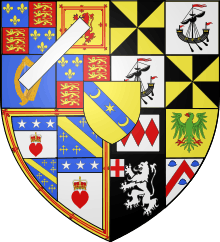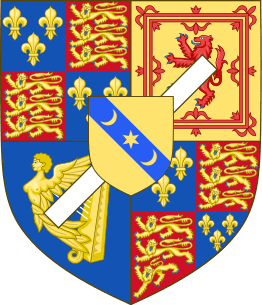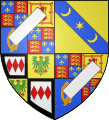Duke of Buccleuch
The title Duke of Buccleuch /bəˈkluː/, formerly also spelt Duke of Buccleugh, is a title in the Peerage of Scotland created twice on 20 April 1663, first for James Scott, 1st Duke of Monmouth and second suo jure for his wife Anne Scott, 4th Countess of Buccleuch. Monmouth, the eldest illegitimate son of Charles II was attainted after his 1685 rebellion, but his wife's title was unaffected and passed on to their descendants, who have successively borne the surnames Scott, Montagu-Scott, Montagu Douglas Scott and Scott again. In 1810, the 3rd Duke of Buccleuch inherited the Dukedom of Queensberry, also in the Peerage of Scotland, thus separating that title from the Marquessate of Queensberry.
| Dukedom of Buccleuch held with Dukedom of Queensberry | |
|---|---|
  | |
| Creation date | 1663 |
| Monarch | Charles II |
| Peerage | Peerage of Scotland |
| First holder | James Scott |
| Present holder | Richard Scott, 10th Duke |
| Heir apparent | Walter Scott, Earl of Dalkeith |
| Remainder to | the 1st Duke's heirs male of the body lawfully begotten |
| Subsidiary titles | Marquess of Dumfriesshire Earl of Buccleuch Earl of Dalkeith Earl of Doncaster Earl of Drumlanrig and Sanquhar Viscount of Nith, Tortholwald and Ross Baron Scott of Tindale Lord Scott of Buccleuch Lord Scott of Whitchester and Eskdaill Lord Douglas of Kilmount, Middlebie and Dornock |
| Seat(s) | Bowhill House Drumlanrig Castle Boughton House |
| Former seat(s) | Dalkeith Palace* Montagu House |
| Motto | Amo ("I love")[1] |
| *Dalkeith Palace remains in the ownership of the Dukes, but is not presently inhabited by them or their family. | |
The substantial origin of the ducal house of the Scotts of Buccleuch dates back to the large grants of lands in Scotland to Sir Walter Scott of Kirkurd and Buccleuch, a border chief, by James II, in consequence of the fall of William Douglas, 8th Earl of Douglas (1452), but the family traced their descent back to a Sir Richard le Scott (1240–1285). Sir Walter Scott of Branxholme and Buccleuch (died 1552) distinguished himself at the Battle of Pinkie Cleugh (1547). His great-grandson Sir Walter was created Lord Scott of Buccleuch in 1606.[2]
Other subsidiary titles associated with the Dukedom of Buccleuch are: Earl of Buccleuch (1619), Earl of Dalkeith (1663) and Lord Scott of Whitchester and Eskdaill (1619) (all in the Peerage of Scotland). The Duke also holds the two subsidiary titles of the attainted Dukedom of Monmouth, namely Earl of Doncaster (1663) and Baron Scott of Tindale (1663) (both in the Peerage of England), and several subsidiary titles associated with the Dukedom of Queensberry, namely Marquess of Dumfriesshire (1683), Earl of Drumlanrig and Sanquhar (1682), Viscount of Nith, Tortholwald and Ross (1682) and Lord Douglas of Kilmount, Middlebie and Dornock (1682) (all in the Peerage of Scotland). The Earldom of Doncaster and Barony of Scott of Tindale had been forfeit at the time of the first Duke's attainder, but the titles were restored to the 2nd Duke of Buccleuch in 1742. Until 1835, the Dukes also held lands in the West Riding of Yorkshire and the ancient title of Lord of Bowland. The Duke of Buccleuch is the hereditary chief of Clan Scott.[3] The holder is one of only five people in the UK to hold two or more different dukedoms, the others being the Duke of Cornwall and Rothesay, the Duke of Hamilton and Brandon, the Duke of Argyll (who holds two dukedoms named Argyll), and the Duke of Richmond, Lennox and Gordon.
The courtesy title used by the Duke's eldest son and heir is Earl of Dalkeith; and that of Lord Dalkeith's eldest son and heir is Lord Eskdaill.
The novelist Sir Walter Scott, Bart., was directly descended of the Lords of Buccleuch. His family history, fancifully interpreted, is the main subject of much of The Lay of the Last Minstrel.
The current Duke of Buccleuch, Richard Scott, the 10th Duke, is the largest private landowner in Scotland with some 280,000 acres (1,100 km2)[4] and chairman of the Buccleuch Group, a holding company with interests in commercial property, rural affairs, food, and beverages. The title originally comes from a holding in the Scottish Borders, near Selkirk.
The family seats are Bowhill House, three miles outside Selkirk, representing the Scott line; Drumlanrig Castle in Dumfries and Galloway, representing the Douglas line; and Boughton House in Northamptonshire, England, representing the Montagu line. These three houses are still lived in by the family and are also open to the public. The family also owns Dalkeith Palace in Midlothian, which is let, and has owned several other country houses and castles in the past. Its historic London residence was Montagu House, Whitehall, now demolished and replaced by the Ministry of Defence.
William Montagu Douglas Scott, The Earl of Dalkeith, who became the 7th Duke of Buccleuch was elected President of St. Andrew's Ambulance Association in 1908. The Presidency of the Association (now St Andrew's First Aid) has been held by the Buccleuch family from that date.
Most of the Dukes of Buccleuch (the 3rd, 4th, 5th, 6th, 7th) are buried in the Buccleuch Memorial Chapel in St. Mary's Episcopal Church, Dalkeith, Midlothian. The 2nd Duke (died 1751) is buried in Eton College Chapel. The most recent Dukes (the 8th and 9th) are buried among the ruins of Melrose Abbey in Melrose.[5]
Feudal barons of Buccleuch (1488)
- David Scott, 1st of Buccleuch (died c. 1491/2)
- Walter Scott, 2nd of Buccleuch (died c. 1504)
- Walter Scott of Branxholme and Buccleuch, 3rd of Buccleuch (died 1552)
- Walter Scott, 4th of Buccleuch (c. 1549–1574)
- Walter Scott, 5th of Buccleuch (1565–1611) (created Lord Scott of Buccleuch in 1606)
Lords Scott of Buccleuch (1606)
- Walter Scott, 1st Lord Scott of Buccleuch (1565–1611), son of the 4th Baron
- Walter Scott, 2nd Lord Scott of Buccleuch (died 1633) (created Earl of Buccleuch in 1619)
Earls of Buccleuch (1619)
- Walter Scott, 1st Earl of Buccleuch (died 1633)
- Francis Scott, 2nd Earl of Buccleuch (1626–1651)
- Mary Scott, 3rd Countess of Buccleuch (1647–1661)
- Anne Scott, 4th Countess of Buccleuch (1651–1732) was created Duchess of Buccleuch in 1663
Dukes of Buccleuch, first Creation (1663)
- James Scott, 1st Duke of Monmouth, 1st Duke of Buccleuch (1649–1685) was executed for the Monmouth Rebellion and his honours forfeit
Dukes of Buccleuch, second Creation (1663)
- Anne Scott, 1st Duchess of Buccleuch (1651–1732)
- Francis Scott, 2nd Duke of Buccleuch (1695–1751)
- Henry Scott, 3rd Duke of Buccleuch, 5th Duke of Queensberry (1746–1812) (succeeded as Duke of Queensberry)
- Charles William Henry Montagu Scott, 4th Duke of Buccleuch, 6th Duke of Queensberry (1772–1819), second son of the 3rd Duke
- Walter Francis Montagu Douglas Scott, 5th Duke of Buccleuch, 7th Duke of Queensberry (1806–1884)
- William Henry Walter Montagu Douglas Scott, 6th Duke of Buccleuch, 8th Duke of Queensberry (1831–1914)
- John Charles Montagu Douglas Scott, 7th Duke of Buccleuch, 9th Duke of Queensberry (1864–1935)
- Walter John Montagu Douglas Scott, 8th Duke of Buccleuch, 10th Duke of Queensberry (1894–1973)
- Walter Francis John Montagu Douglas Scott, 9th Duke of Buccleuch, 11th Duke of Queensberry (1923–2007)
- Richard Walter John Montagu Douglas Scott, 10th Duke of Buccleuch, 12th Duke of Queensberry (born 1954)
The heir apparent is the present holder's son Walter John Francis Montagu Douglas Scott, Earl of Dalkeith (born 1984).
Coats of Arms
.svg.png) Ancestral Scott arms: Or on a bend azure a mullet of six points between two crescents of the field'[6]
Ancestral Scott arms: Or on a bend azure a mullet of six points between two crescents of the field'[6] Arms of the 1st Duke of Monmouth & Buccleuch
Arms of the 1st Duke of Monmouth & Buccleuch Arms of the 4th Duke of Buccleuch
Arms of the 4th Duke of Buccleuch.svg.png) Arms of the 5th Duke of Buccleuch
Arms of the 5th Duke of Buccleuch Arms of the 8th to 10th Duke of Buccleuch[7]
Arms of the 8th to 10th Duke of Buccleuch[7]
 |
|
Family Tree
In media
- Nick Carraway, the narrator of F. Scott Fitzgerald's The Great Gatsby, says his family has "a tradition that we're descended from the Dukes of Buccleuch", but then points out that this is not true.
See also
- Buccleuch, Scottish Borders
- Clan Douglas
- Clan Scott
- Clan Stewart as they are descendants of the Duke of Monmouth, the eldest illegitimate son of King Charles II
- Duke of Buccleugh (ship) – several ships with that name
References
- Berry, William; Glover, Robert (1828). Encyclopædia Heraldica: Or, Complete Dictionary of Heraldry. Published by the author. p. 460.
-

- "Requirements for recognition". The Standing Council of Scottish Chiefs. Archived from the original on 7 August 2012.
- Ross, David (5 June 2013). "Questions raised over land swap deal with billionaire". The Herald. Retrieved 12 January 2015.
- "St Mary's Episcopal Chapel - Clan Scott Scotland".
- Scots Peerage, p. 249
- scotarmigers.net